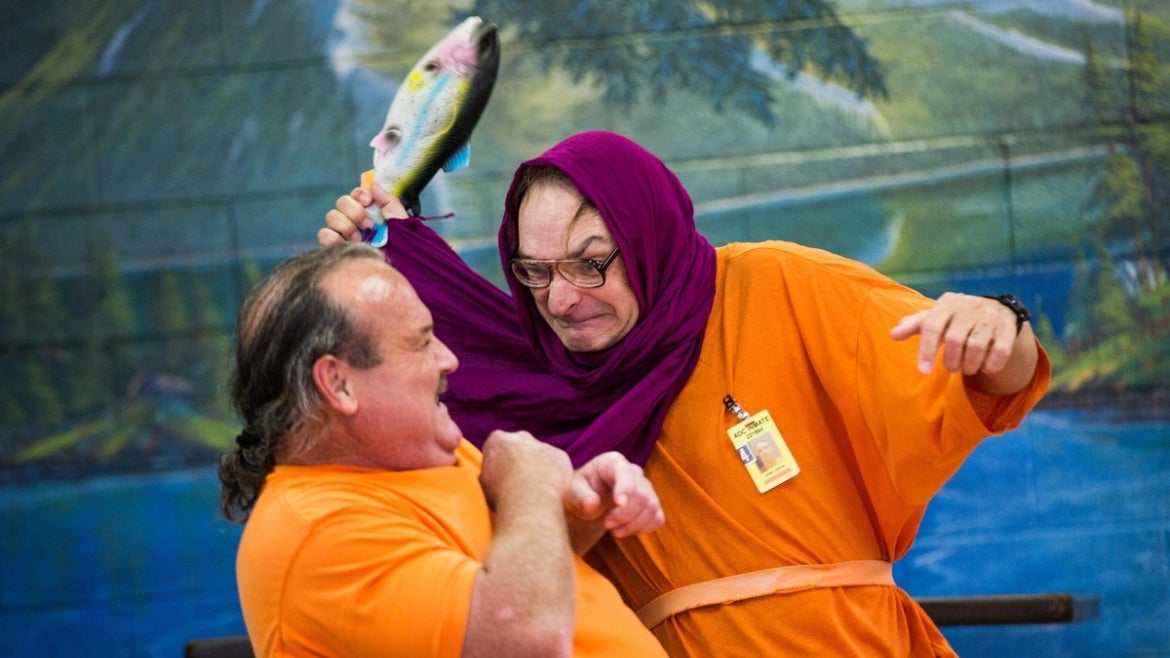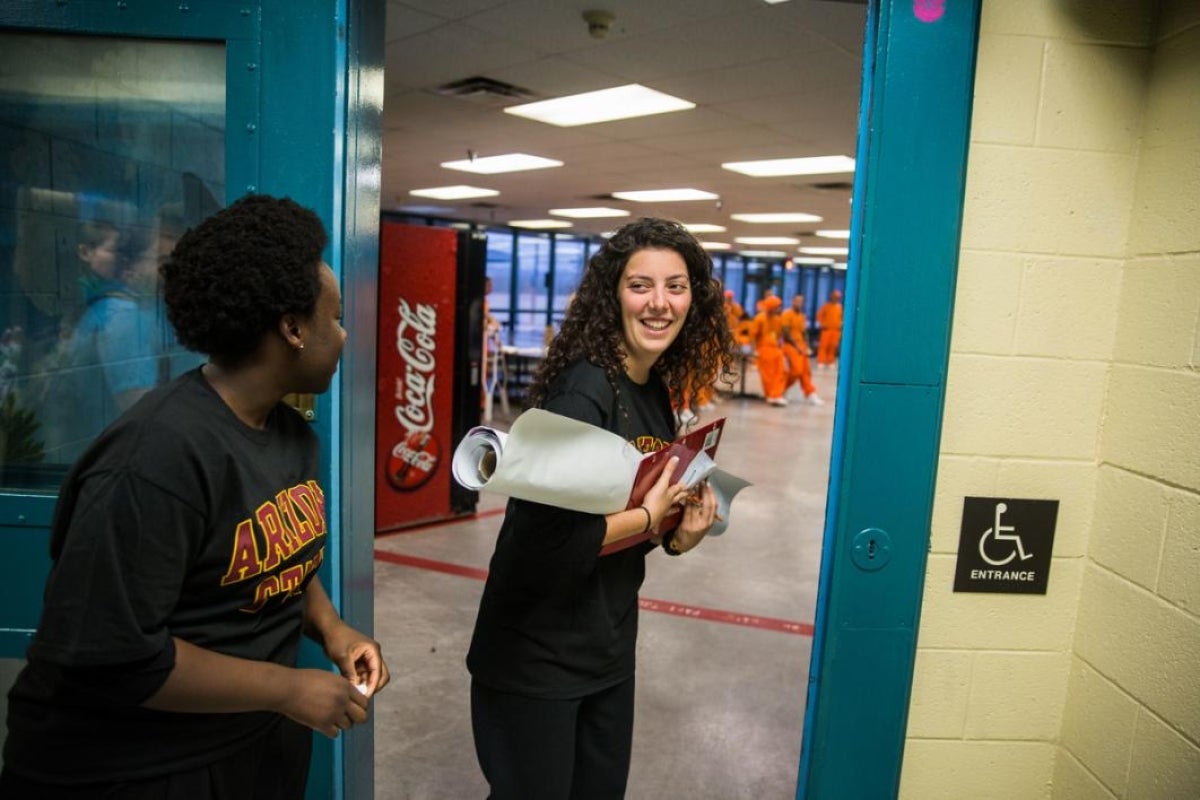Rania Zeineddine peers through a wall of windows, watching the audience fill the seats in this makeshift theater.
She and her fellow actors start the show tapping on the glass to get the attention of her co-stars on the other side. One of them, Charles Thigpen, comes over and flattens his palms against the glass. She does the same before they start laughing and mimicking each other as if the window were a mirror.
This will be the closest thing to physical contact these actors will have in their performance. Once the seats are filled and the doors open, the actors will have one strict rule to follow: No touching.
This isn’t an avant-garde theater edict. This is a condition of staging a play inside the boundaries of Eyman State Prison.
Zeineddine is one of three Arizona State University undergrads who coordinated and crafted “Free Drama,” a 45-minute joint production between the students and Eyman inmates that stages the journal entries these prisoners and students exchanged during the course of a semester in the School of Film, Dance and Theatre’sThe School of Film, Dance and Theatre is part of ASU's Herberger Institute for Design and the Arts. Theatre Across Prison Walls class.
The doors finally open and the three students wearing ASU shirts walk inside, ready to join the prisoners wearing jumpsuits with “ADC” emblazoned on them.
There isn’t apprehension or fear. Rather, there are smiles and the joy coming from actors who get to perform their stories in front of an actual audience.

Inmate Dusty Lewis plays the nagging wife who beats "husband" Gregory Fulton during a scene written in "Free Drama."
Photos by Deanna Dent/ASU Now
An inspired design
Rivka Rocchio has spent the past two years teaching drama to inmates inside Arizona’s Eyman Prison. But it wasn’t until this semester that the ASU graduate student decided to incorporate undergrads into the process.
She liked the idea of teaching a class that involved an exchange of ideas between her students in prison and her undergraduate drama students. The idea was approved, but there was one problem: The two sides wouldn’t be able to regularly meet to create a production. So Rocchio, who is using this project as part of her graduate thesis, improvised.
“We asked them to create a master list of themes and motifs that they were interested in, so of those five themes they were interested in, I created a series of journal prompts,” Rocchio said.
They settled on five themes: going home, joy or enjoyment inside of prison, emotions, animals, and stereotypes and layers. Each week Rocchio would ask the students to write journal entries relating to the prompts. After the entries were exchanged between classes, the students selected the pieces that best fulfilled the themes.
Rocchio then gave students in each classes prompts to delve into deeper stories that were developed into group scenes or monologues.
But the exercise become more intriguing when Rocchio decided to have the students and prisoners swap stories for the performance.
The results were varied — an inmate spoke about a first summer job interview at Starbucks, an ASU theater major performed a monologue documenting drug addiction and redemption through the Bible and religion.
“That really gave the students the opportunity to try on each others’ stories, to live in that identity for a little while and experience what it would be like, what it would feel like to say as a 23-year-old college student I’ve been a drug addict for 40 years and this is the impact that it’s had on my life,” Rocchio said.
Salome Chuma, an ASU theater major, was cast in an inmate’s tale of fighting with a doctor while his newborn child was in the NICU.
“That was the first time he had ever mentioned that story to anyone else, and he was like, ‘It was interesting that this is a story that’s personal to me and it’s in my memory and now it’s something that you have in your memory now. It’s weird that it’s living in two different people, and I’m seeing that lived out through you,’ ” Chuma said. “As actors you kind of never forget a monologue, or a show, so it’s now a part of you just how it’s a part of them too … it’s crazy.”
Performing with passion
Back in the Cook Unit of Eyman Prison, Chuma sits in a chair on “stage” during the performance in front of inmates and prison administrators.
Her hands are empty, but she relays a monologue about a letter inmate T.J. Garrison had written to his mom, who died during his time in prison. The dialogue explained his attempts to better himself and to better understand his mother’s motivations.
Garrison is soft-spoken and contemplative. His fingers are tattooed with letters that spell out “beauty.” He was convicted in 1997 at the age of 20 and wrote his journal entry on a day he simply “felt open,” which many Cook Unit inmates say is rare.
“When she performed the “mamalogue” I cried, I sat on the side and I was like, ‘Man, these people are going to see me cry,’ and I didn’t care and I let it go,” Garrison said. “To see something that I had written, put down and is going to be acted by somebody else, it made my heart swell, it made my heart swell a lot.”
Afterward, he thanked Chuma for the performance. She thanked him for sharing his emotions and words.
“I didn’t think anything I could do could ever have that kind of effect on somebody, and that felt really powerful,” Chuma said.
Much of the show, which veered from poignant introspection to comedy, inspired the same sentiments between parties.
As the production closed, Rocchio gives thanks to the Arizona Department of Corrections, her graduate adviser and to her students before asking the entire group to paint a large white banner with their thoughts about the performance with markers or fingers. Inmate Garrison writes a large and colorful “Namaste” while B. Brewer, his tattoed hands covered in purple paint, makes hand stamp prints up and down the banner.
An appreciated understanding
Rocchio said the moment this unique experience “clicked” for her students was during the hourlong car ride back to ASU from the prison in Florence. Her students related their initial apprehension and how it gave way to an understanding that drama became a shared experience to better understand another person they had seen as so different from themselves.
“That’s what I want you to get out of it,” Rocchio said. “You are people and these are people and you connect through the passions that you have for theater and art.”
Story, photos and video by Deanna Dent/ASU Now
More Arts, humanities and education

ASU professor, Arizona inmate work to rehabilitate the 'imprisoned mind'
An Arizona State University professor has collaborated with an Arizona inmate on a book that examines why investing in healing prisoners would benefit everyone.“Imprisoned Minds: Lost Boys, Trapped…
Illuminating legacy at ASU
In 2020, the ASU Art Museum unveiled a groundbreaking installation, "Point Cloud (ASU)," by renowned artist Leo Villareal. The art piece was given a permanent home on the Tempe campus in 2024 thanks…

Name change for ASU's Mary Lou Fulton Teachers College reflects college's mission
Arizona State University’s Mary Lou Fulton Teachers College has a new name: the Mary Lou Fulton College for Teaching and Learning Innovation.The name change, which will be completed in time for the…







